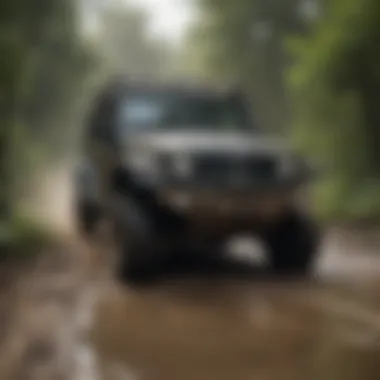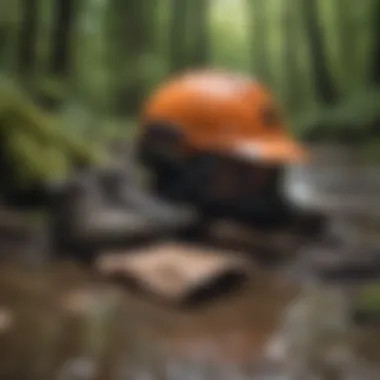Exploring Mud Riding in Miami: An In-Depth Analysis


Intro
Mud riding in Miami is an exhilarating outdoor activity that attracts many enthusiasts. However, it also raises important questions about environmental impact and safety. In this article, we will navigate through the intricacies of mud riding in Miami. Our focus will include gear requirements, safety precautions, as well as the community dynamics related to this popular pastime. Understanding how mud riding interacts with urban settings is essential for both enjoyment and conservation efforts. This comprehensive approach aims to provide valuable insights for both enthusiasts and eco-conscious individuals.
Environmental Implications
Engaging in mud riding indisputably affects the environment. This section assays the implications:
- Soil Erosion: The act of mud riding can destabilize soil structures, leading to increased erosion. The movement of vehicles can strip away protective vegetation, making the land more susceptible to wear.
- Wildlife Disturbance: Off-road activities can disrupt natural habitats. It is crucial to consider how noise and disturbance may affect local animal populations.
- Water Quality: Mud mixing with oils and other substances can seep into waterways. This can impact aquatic life and also drinking water sources.
Efforts must be made to mitigate these adverse effects while enjoying this thrilling sport.
Safety Considerations
Safety is paramount when mud riding. Riders should prioritize the following:
- Gear Requirements: Proper gear is necessary. A good helmet, sturdy boots, and appropriate clothing are essential. Additional protective gear may include knee pads and gloves.
- Vehicle Readiness: Ensure that vehicles are in good condition. Check for adequate tire tread and assess the vehicle’s overall state before heading out.
- Ride with Friends: It is always safer to ride in groups. This ensures assistance is available in case of emergencies.
Adhering to safety measures can significantly reduce the risk of accidents.
Community Dynamics
The community around mud riding is diverse. Participants find camaraderie through shared interests. Local clubs and groups often hold events, which create vibrant networks of riders. These events not only offer a chance to enjoy mud riding but also to share knowledge about safe practices and environmental stewardship.
Local regulations should guide activities. Understanding these rules helps protect both riders and natural landscapes. Engaging in responsible mud riding practices fosters a positive relationship between the community and the environment.
Closure
Exploring mud riding in Miami encompasses much more than mere excitement. It involves a deep consideration of environmental impact, safety, and community relations. Through informed practices, mud riders can enjoy their hobby while remaining mindful of its repercussions. Thus, this article serves as a guide for enthusiasts who wish to enjoy the thrill of mud riding responsibly.
Understanding Mud Riding
Mud riding is not merely a recreational activity; it represents a distinct subculture within off-roading that both challenges and rewards its enthusiasts. Understanding mud riding in Miami involves grasping the various dynamics at play, from the environmental implications to the community interactions that define this activity. This section introduces the foundational concepts surrounding mud riding, elucidates its significance, and examines key themes relevant to participants and stakeholders.
Definition and Overview
Mud riding is an outdoor activity that involves driving vehicles through muddy terrain. Typically, this includes specialized off-road vehicles that are designed to handle rough conditions. This activity can occur in a variety of settings, from designated parks to informal trails. Many enthusiasts are drawn to the thrill of navigating through dense mud, which can be both challenging and exhilarating.
An important aspect of mud riding lies in the choice of vehicle. Common options include ATVs (All-Terrain Vehicles), dirt bikes, and modified trucks. Each vehicle type offers different advantages and presents unique challenges, influencing the rider's experience and safety. The participation in this activity also fosters a sense of belonging within a community of like-minded individuals, emphasizing shared values related to adventure, exploration, and environmental stewardship.
Historical Context
The roots of mud riding can be traced back to the evolution of off-road vehicles in the mid-20th century. Initially, these vehicles were designed for agriculture and military applications. Over time, their capabilities attracted recreational users who sought new ways to explore natural landscapes.
In the context of Miami, local mud riding culture began to gain traction during the 1990s. As urban development expanded, mud riders sought out alternative spaces to pursue their passion. This led to a delicate balance between enjoying these outdoor experiences and protecting the environment from potential harm. Various local clubs and organizations emerged to promote responsible riding, advocating for sustainable practices and compliance with environmental regulations.
Understanding the historical context of mud riding is crucial for contextualizing present-day challenges and opportunities. It helps participants appreciate the evolution of the sport while recognizing the importance of preserving access to riding areas in the face of increasing urbanization.
Mud Riding Locations in Miami
Mud riding can be an exhilarating activity that requires the right locations to enhance the experience. In Miami, specific areas stand out due to their suitability for this outdoor pursuit. Knowing the best riding spots allows enthusiasts to fully enjoy this sport while minimizing environmental impact and abiding by local regulations.
Popular Areas for Mud Riding
Miami has several noteworthy locations designed for mud riding. These include:
- Big Cypress National Preserve: This vast area offers a mix of trails and open mud pits. Riders often enjoy the scenic views of diverse plant and animal life here, making it ideal for both recreation and nature observation.
- Redland: Located south of Miami, Redland has many off-road trails. These trails are often utilized by enthusiasts for mud riding due to their varied terrains.
- The Everglades: Parts of the Everglades National Park provide areas suitable for mud riding. Riders must be cautious as certain regions have restrictions that protect the natural environment.
Riding in these areas allows participants to connect with the landscape while maximizing their enjoyment. However, riders must observe any applicable regulations that apply to these locations.
Regulated Riding Zones


Regulated zones are crucial for ensuring that mud riding can coexist with conservation efforts. In Miami, some areas are designated specifically for this purpose.
- Local Regulations: Certain parks and recreation areas have designated mud riding zones to control land use and ecological impact. Understanding these regulations is vital for riders to ensure compliance and contribute to sustainable practices.
- Permitting Requirements: In some locations, riders may need specific permits to access registered areas. These permits can regulate the number of riders and manage the environmental impact effectively.
"Engaging in mud riding under regulated guidelines ensures the sustainability of natural resources and helps maintain the ecosystem."
By focusing on regulated zones, riders can enjoy the sport responsibly. This also aids local authorities in conservation efforts and aids in protecting the environment.
Environmental Considerations
The relationship between mud riding and the environment raises crucial questions about sustainability and ecological balance. Mud riding can significantly impact local ecosystems, which includes the disruption of habitats and natural processes. Understanding these impacts is essential for both riders and conservationists alike. By addressing environmental considerations, this article aims to foster responsible practices among enthusiasts.
Impact on Local Ecosystems
Mud riding introduces various challenges to local ecosystems in Miami. These activities can alter the natural landscape, often leading to habitat destruction. For instance, vehicles moving through wetlands may disturb the fauna and flora that have adapted to specific conditions. Furthermore, this disturbance can lead to the displacement of species that rely on those habitats, disrupting food chains.
- Invasive species may also gain ground due to changes in the soil composition after erosion caused by vehicles.
- Water quality can suffer from sediment runoff, which may lead to harmful chemical pollutants entering local waterways.
It is necessary to conduct thorough studies to quantify these effects and develop strategies that mitigate damage while allowing enjoyment of mud riding.
Soil Erosion and Degradation
Soil erosion is a significant concern linked with mud riding. Heavy machinery and repeated trips over the same terrain weaken soil structure. This deterioration not only affects the ability of the land to support vegetation but also increases the likelihood of mudslides during heavy rains.
- Eroded soil can wash into rivers and lakes, leading to sedimentation that impacts aquatic ecosystems.
- The loss of fertile topsoil reduces the land's productivity, which can affect agriculture and local economies.
Preventive measures such as designated trails can help minimize erosion by directing traffic and maintaining soil integrity.
Conservation Efforts
Efforts to protect local ecosystems in the context of mud riding include a number of initiatives designed to balance recreation with conservation. Collaboration between local governments, environmental organizations, and riders is essential.
- Setting up stewardship programs helps foster a sense of responsibility among riders.
- Education campaigns focused on responsible riding practices can create greater awareness of the environmental impacts.
- Establishing protected zones where mud riding is restricted could help in the preservation of sensitive habitats.
Ultimately, these conservation efforts play a pivotal role in ensuring that mud riding can coexist with ecological preservation. Riders must recognize their influence and participate in initiatives that promote sustainable enjoyment of the sport.
Safety Guidelines for Mud Riders
Understanding and adhering to safety guidelines is crucial for anyone engaging in mud riding. Proper safety measures not only protect the individuals riding but also help safeguard the surrounding environment. The risks associated with mud riding vary, stemming from the terrain, weather conditions, and vehicle type. Thus, it's essential to recognize these factors to ensure a rewarding and secure experience.
Essential Safety Equipment
Each mud rider should equip themselves with specific safety gear to minimize risks. Some of the most important items include:
- Helmet: A robust helmet is manditory. It protects the head from serious injuries in case of accidents. A full-face helmet provides the best coverage.
- Goggles: These prevent mud and debris from entering the eyes, ensuring clear vision while riding. Clear or tinted options can be chosen depending on the environment.
- Collar and Pads: Neck braces and protective pads are important. They shield vital areas of the body from injuries during rough rides.
- Gloves and Boots: Skilled riders use gloves for better grip and boots with good ankle support to protect their feet and ensure control over the vehicle.
- Reflective Clothing: Visibility is key, especially in low-light conditions. Wearing bright or reflective clothing enhances safety from other riders or vehicles in the vicinity.
These equipment pieces help form a safety net around the rider, making it easier to enjoy mud riding responsibly.
Riding Techniques
Applying effective riding techniques is just as important as having the proper gear. Several methods can enhance safety and performance:
- Throttle Control: Riders need to learn to manage their speed on different surfaces. Sudden acceleration can lead to loss of control, especially in loose mud.
- Body Positioning: Maintaining correct posture on the vehicle helps with balance and control. Riders should lean into turns and keep their weight centered to navigate effectively.
- Braking Techniques: It’s vital to understand the distinction between front and rear brakes. Making use of both brakes evenly can prevent skidding and promote safer stopping.
- Obstacle Navigation: Practice should be done in straightforward terrains to gain confidence. Muddy roads can conceal hazards like ruts or debris; hence, riding slowly and scanning ahead is wise.
"Having the right equipment and techniques can dramatically change a rider's ability to handle unexpected challenges in the mud."
Incorporating these safety guidelines and techniques into each mud riding session ensures that the experience remains enjoyable and safe. Riders should always prioritize personal safety, which in turn respects the collective enjoyment of this rugged activity.
Gear and Preparation
Gear and preparation are critical aspects of mud riding, especially in a unique environment like Miami. Proper preparation enhances not only the enjoyment of the activity but also ensures the safety of the rider and protects the ecosystems where mud riding occurs. This section will provide insights into the types of vehicles suitable for the terrain and the necessary maintenance considerations.


Types of Vehicles Suitable for Mud Riding
When discussing vehicles for mud riding, choices are varied and depend on the rider's preferences and the characteristics of the terrain. Some popular options include:
- All-Terrain Vehicles (ATVs): Highly favored for their versatility and ability to maneuver through challenging environments. ATVs are robust and can handle mud without difficulties.
- Dirt Bikes: These are lighter and built for speed and agility on muddy trails. However, they require skilled handling, especially in slick conditions.
- Mud Trucks: Specifically modified trucks can provide the power needed for thick mud. They typically have larger tires and heightened suspension systems to navigate difficult areas effectively.
- Side-by-Sides (UTVs): Offering stability and space for passengers, UTVs are ideal for group outings. They come equipped with features designed for mud riding, such as enhanced tractions and protective chassis.
Each vehicle type has its own set of advantages and considerations. Factors such as tire size, engine power, and overall weight play a role in overall performance in mud.
Maintenance Considerations
Ensuring that your chosen vehicle is well-maintained is essential for safe mud riding. Regular maintenance can substantially prolong the life of the vehicle and prevent breakdowns in remote areas. Some key maintenance tips include:
- Tire Care: Inspecting tires for wear and tear is crucial. Mud riding can rapidly degrade tread patterns, making it imperative to have suitable tires with good grip.
- Fluid Checks: Regularly examine fluid levels, including oil, coolant, and brake fluid. Consistent checks help avoid unexpected failures and maintain the vehicle's efficiency.
- Cleaning: After mud riding, cleaning the vehicle is vital. Mud can cause corrosion and damage sensitive components if left unchecked. Rinsing off the mud and ensuring all parts are clean can prevent long-term issues.
- Battery Inspection: Ensure the battery connections are secure and the terminals are free from corrosion. A weak battery can lead to starting issues, especially after a muddy outing.
Proper gear and importantly preparation can significantly enhance one’s riding experience while also preserving the natural environment where this thrilling activity takes place.
Community and Culture
Understanding the community and culture surrounding mud riding in Miami is crucial. This aspect offers insights into how individuals interact, share knowledge, and create networks centered around this outdoor activity. A strong community provides emotional support and fosters a sense of belonging among enthusiasts. It can also drive awareness about safe riding practices and environmental stewardship, which is essential given the ecological implications of this sport.
Moreover, the culture surrounding mud riding is marked by camaraderie and shared enthusiasm. Participants often gather to exchange tips, experiences, and maintenance advice, which enhances safety and enjoyment. This social fabric enrichens the overall experience for mud riders, making it not just a recreational activity but a vehicle for community building.
The Mud Riding Community in Miami
The mud riding community in Miami is diverse and vibrant. It includes individuals of all ages, from young enthusiasts just beginning their journey to seasoned riders who have honed their skills over the years. This community is characterized by its inclusiveness, welcoming newcomers and offering a space for shared interests. Online forums, social media groups, and local clubs often serve as platforms for connection.
Many riders participate in discussions on platforms such as Reddit and Facebook, where they share tips on vehicle maintenance or recommend riding spots. Participants often highlight their experiences in mud riding adventures, contributing to a collective knowledge pool. This cross-sharing makes the community stronger and more informed.
Social media also plays a vital role in community engagement. Photographs and videos capture the excitement of mud riding events and special gatherings, serving to inspire others. Additionally, these platforms often promote safety and environmental awareness, an essential component of responsible riding practices.
Events and Gatherings
Events and gatherings are pivotal in fostering community spirit among mud riders in Miami. These occasions can range from informal meet-ups to elaborately organized competitions. They provide an excellent opportunity for riders to come together, share their passion, and build relationships.
Prominent events often include mud riding competitions and charity rides. These gatherings generate enthusiasm and motivate participation. Charity events serve a dual purpose—collecting funds for causes while promoting responsible riding practices and community cohesion. Attendees are encouraged to engage in discussions that focus on the environmental impact of their activities, further emphasizing the community's commitment to stewardship.
Notably, many riders participate in local meet-ups scheduled through social media. These informal gatherings allow enthusiasts to practice together and learn from each other's strengths. Such events help foster a culture of safety as experienced riders often share insights into techniques and gear selection. This knowledge transfer can prove invaluable, particularly for newcomers looking to navigate the nuances of mud riding.
In summary, the community and culture surrounding mud riding in Miami enrich the experiences of riders. It builds a collective identity that values knowledge sharing, safety, and environmental responsibility, ensuring the longevity and sustainability of this thrilling activity.
Legal Framework
The legal framework surrounding mud riding in Miami is crucial for both enthusiasts and conservationists. Understanding this framework provides clarity on how the activity can be enjoyed responsibly while also safeguarding the environment. Laws and regulations not only aim to ensure the safety of riders but also protect natural habitats that could potentially be harmed by reckless riding. Furthermore, being informed about these regulations fosters a culture of respect and accountability within the mud riding community.
Local Laws and Restrictions
Local laws related to mud riding are designed to mitigate environmental impact and regulate where this activity can take place. In Miami, these laws can include restrictions on noise levels, areas allowed for riding, and the types of vehicles permitted. For example, certain wetlands or protected areas may be off-limits to prevent damage to wildlife habitats and to preserve water quality. Riders are advised to consult the Miami-Dade County Code, which provides detailed information on ordinances relevant to off-road activities.
"Understanding local laws is essential for safe and responsible mud riding, ensuring both rider enjoyment and environmental protection."
Specific restrictions can vary by location within the city, so it is vital for riders to be aware of the specific rules governing the area where they intend to ride. Compliance with such laws not only keeps riders out of legal trouble but also contributes to the conservation of Miami's unique ecological landscapes.
Permitting and Compliance
Permitting is another key aspect of the legal framework for mud riding in Miami. Depending on the chosen location, riders may be required to obtain permits which outline the terms of use. These permits are put in place to ensure that riders follow regulations designed to minimize disruption to the environment and surrounding communities.
To secure a permit, riders usually need to provide details about the type of vehicle being used, the intended riding area, and the timeframe for the activity. Engaging with local authorities ensures compliance and helps in understanding the specific guidelines that must be followed. Riders should consider the benefits of adhering to the permitting process, which include:
- Access to designated riding areas: Some areas may only be accessible through a permit system.
- Protection from legal issues: Proper permits can shield riders from potential fines or penalties.
- Enhanced safety measures: Requirements for safety equipment may be outlined in permit guidelines, promoting a safer experience for all.
It is imperative for the riding community to recognize the importance of obtaining the necessary permits. This not only aligns with legal expectations but also reflects a commitment to responsible riding and environmental stewardship.


The Intersection of Mud Riding and Urban Development
In discussing mud riding within the context of Miami, it is essential to examine its relationship with urban development. This intertwined connection presents unique challenges and potential advantages for enthusiasts and urban planners alike. As cities expand, they increasingly encroach on natural mud riding spaces, which can lead to both conflict and innovation in sustainable practices.
Challenges in Urban Settings
Urban settings pose significant challenges for mud riding. As residential and commercial developments rise, traditional riding spots dwindle. This reduction in space forces riders to compete for limited areas, often leading to overcrowding and infrastructural stress.
Moreover, urban mud riding can cause conflicts with residents and wildlife. Noise pollution from vehicles and the disturbance of local habitats often create friction between mud riders and environmental advocates. These tensions underscore the importance of establishing designated riding zones that meet both recreational and ecological needs.
Some of the most pressing challenges include:
- Noise Pollution: Increased activity disrupts community peace.
- Erosion and Degradation: Constrained spaces may suffer from heavy use.
- Compliance: Understanding and adhering to local regulations becomes essential for riders.
Opportunities for Sustainable Practices
Despite these challenges, urban settings also offer unique opportunities for integrating sustainable practices into mud riding. Urban planners can work with the riding community to create environments that allow for recreational activities while preserving the local ecosystem.
One promising approach is the establishment of multi-use trails that accommodate mud riders, hikers, and wildlife. These trails can be designed to minimize soil compaction and erosion while promoting responsible use of shared spaces. Additionally, community awareness campaigns can be developed to educate riders about eco-friendly practices, enhancing the relationship between mud riding and environmental stewardship.
Key opportunities include:
- Creation of Designated Riding Areas: These areas can mitigate conflicts and support conservation goals.
- Partnerships with Environmental Groups: Collaborative efforts can improve local ecosystems while allowing for mud riding.
- Event Planning for Awareness: Hosting mud riding events focused on sustainability can raise awareness and promote responsible riding.
"By working together, urban planners and the mud riding community can craft solutions that respect both recreation and ecological integrity."
Future of Mud Riding in Miami
The landscape of mud riding in Miami is shifting, influenced by evolving trends and increasing awareness around the activity's impacts. Understanding the future of this sport is crucial for participants, environmental advocates, and urban planners.
Trends and Innovations
Several emerging trends indicate a new era for mud riding. Firstly, technology integration into vehicles is redefining performance capabilities. Manufacturers like Polaris and Can-Am are developing all-terrain vehicles (ATVs) that optimize for mud environments, featuring enhanced suspension and modified engines. This trend not only improves safety but also elevates the thrill of the ride.
Another notable innovation includes the use of sustainable materials in vehicle construction and modifications. This shift aims to mitigate environmental impact, which appeals to a conscientious audience. Moreover, there is a growing emphasis on better fuel efficiency. The rise of electric all-terrain vehicles is set to make mud riding more environmentally friendly.
Community-led initiatives are also becoming more prominent. Groups are organizing events that focus on education regarding responsible riding and ecosystem preservation.
Potential for Growth and Regulation
The potential for growth in mud riding is substantial. Miami's varied landscapes offer abundant opportunities for expansion. However, with growth comes the need for enhanced regulation. Urbanization continues to encroach on traditional riding areas, necessitating a careful balance between urban development and outdoor recreation.
Regulations related to safety gear, vehicle emissions, and land usage are vital. Local governments should consider adaptive frameworks that facilitate responsible riding while protecting ecosystems. This collaborative approach could embrace riders' perspectives, ensuring their enjoyment of the sport aligns with environmental stewardship.
As awareness about the ecological footprint of mud riding increases, participants may advocate for environmentally aware practices, such as rest areas and designated trails that lessen soil compaction and erosion.
By prioritizing dialogue between riders, environmentalists, and local authorities, Miami can cultivate a sustainable mud riding culture that respects both tradition and the evolving urban landscape.
"Balancing passion with responsibility will determine the future of mud riding in urban environments like Miami."
Closure
The examination of mud riding within the context of Miami establishes its significance from both recreational and environmental perspectives. This outdoor activity is not merely a pastime but a complex engagement that intertwines community, ecology, and regulations. Enthusiasts often find a sense of belonging in the mud riding community, where shared experiences and events foster camaraderie among participants.
Summary of Key Points
- Understanding Mud Riding: We explored the origins and current dynamics of mud riding, reinforcing its cultural relevance in Miami.
- Legal Framework: Local laws shape the activity, providing structure that riders must adhere to, which is essential for maintaining balance between enjoyment and legal compliance.
- Environmental Impact: The effects of mud riding on local ecosystems cannot be overstated. Riders must recognize their role in protecting these environments while also pursuing their passion.
- Future Trends: With innovations in equipment and growing awareness among riders, there is potential for sustainable practices that align enjoyment with ecological stewardship.
The conclusion stresses the need for a balanced approach in mud riding, with an emphasis on responsible practices. With proper knowledge, riders can contribute positively to the spaces they enjoy, ensuring that future generations can also partake in this enriching activity.
Call for Responsible Riding Practices
To sustain the enjoyment of mud riding, it is vital for participants to commit to responsible practices. This includes following local laws and respecting designated riding areas. Riders should prioritize equipment maintenance to minimize environmental impact. Therefore, engaging in regular checks on vehicles and ensuring tire cleanliness are fundamental steps that can substantially reduce soil disruption.
Moreover, involvement in local conservation efforts can enhance the mutual relationship between the riding community and the environment. Participating in clean-up events helps preserve the natural beauty of riding areas. Riders must cultivate an awareness of the ecosystems they navigate. Protecting wildlife habitats and advocating for sustainable land-use practices are integral aspects that can redefine mud riding in a modern context.
"Mud riding is not just about thrill; it's also an opportunity for guardianship over precious landscapes."
By embracing these principles, we can ensure that mud riding continues to thrive in Miami, providing adventure while honoring our duty to the environment.







